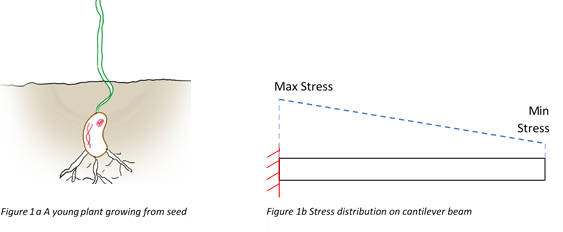Tropism is the term used to describe the response, normally orientation and growth, of a plant towards or away from a stimulus.
There exist many types of tropism in nature, including:
- • Gravitropism – Reorientation of angle of growth relative to gravity
- • Phototropism – Bending growth toward light stimulus
- • Hydrotropism – growth or turning of plant roots towards or away from moisture
- • Thigmotropism – directional response to touch or physical contact with a solid object
Tropism is a three-step process that involves perception, signal transduction and response. The response will involve hormones, a concentration change or translation, to or from an area in the plant.
In the Blind Watchmaker system, the environment contains stimuli that the organism will respond to, for example, growing towards a stimulus as in phototropism, or the organism size may change in response to a different stimulus.
From an engineering design perspective, if we consider a cantilever beam, analogous to a young plant growing from seed, Figure 1a, assuming a fixed end at the ‘ground surface’ and uniformly loaded, the stress along the beam would be as shown in Figure 1b.

A logical engineering design response to high stress is to increase the cross-sectional area on which it acts since stress is inversely proportional to area.
Tropism in the Blind Watchmaker System…
In our system, development, which is controlled through the presence and concentration of hormone, just as plants in nature are, the organism would respond to stress levels in cells by the action of ‘Stresstropism’.
‘Stresstropism’ would perceive the stress level in the cells of the organism, create a signal to trigger a response, change the concentration of growth hormone that would increase the cross-sectional area of the cell and thus reduce the stresses of that cell.
This would result in an organism that resembled that of Figure 2.

